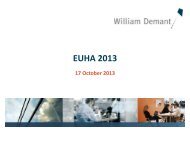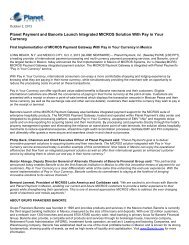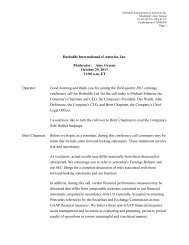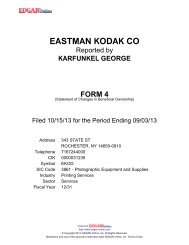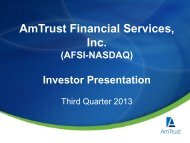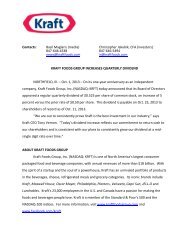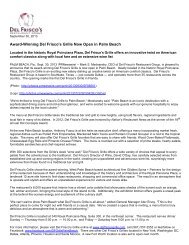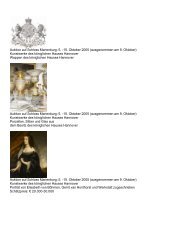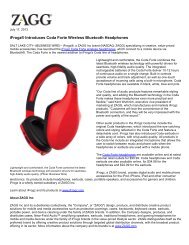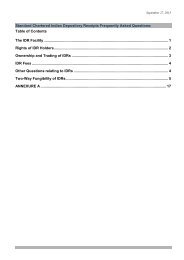Hypercom Corporation Annual Report - CiteSeer
Hypercom Corporation Annual Report - CiteSeer
Hypercom Corporation Annual Report - CiteSeer
You also want an ePaper? Increase the reach of your titles
YUMPU automatically turns print PDFs into web optimized ePapers that Google loves.
On January 1, 2009, the Company adopted a new accounting standard regarding business combinations that apply to all<br />
transactions and other events in which one entity obtains control over one or more other businesses. The standard requires the fair<br />
value of the purchase price, including the issuance of equity securities, to be determined on the acquisition date. The standard requires<br />
an acquirer to recognize the assets acquired, the liabilities assumed, and any non-controlling interests in the acquiree at the acquisition<br />
date measured at their fair values as of that date with limited exceptions specified in the standard. This standard also requires<br />
acquisition costs to be expensed as incurred and restructuring costs to be expensed in periods after the acquisition date. Earn-outs and<br />
other forms of contingent consideration are to be recorded at fair value on the acquisition date. Changes in accounting for deferred tax<br />
asset valuation allowances and acquired income tax uncertainties after the measurement period will be recognized in earnings rather<br />
than as an adjustment to the cost of the acquisition. This standard generally applies prospectively to business combinations for which<br />
the acquisition date is on or after January 1, 2009. See Note 17 for the impact on the Company’s consolidated financial position and<br />
results of operations.<br />
On January 1, 2009, the Company adopted a new standard that requires non-controlling interests or minority interests to be<br />
treated as a separate component of equity, not as a liability or other item outside of permanent equity. Upon a loss of control, the<br />
interest sold, as well as any interest retained, is required to be measured at fair value, with any gain or loss recognized in earnings.<br />
Assets and liabilities will not change for subsequent purchase or sale transactions with non-controlling interests as long as control is<br />
maintained. Differences between the fair value of consideration paid or received and the carrying value of non-controlling interests are<br />
to be recognized as an adjustment to the parent interest’s equity. The implementation of this standard did not have a material impact<br />
on the Company’s consolidated financial position, results of operations or cash flows.<br />
In September 2006, FASB issued guidance that defines fair value, establishes a framework for measuring fair value in GAAP<br />
and expands disclosures about fair value measurements. This standard is generally effective for years beginning after December 15,<br />
2007. The Company adopted this standard on January 1, 2008 with respect to the Company’s financial assets and liabilities, which did<br />
not have a material impact on its consolidated financial position, results of operations or cash flows. The Company adopted this<br />
standard with respect to its non-financial assets and liabilities effective January 1, 2009. The implementation of this standard did not<br />
have a material impact on the Company’s consolidated financial position, results of operations or cash flows.<br />
In April 2009, FASB issued guidance that requires fair value disclosures in interim and annual financial statements to provide<br />
for more timely information about the effects of current market conditions on financial instruments. This standard is effective for<br />
interim and annual periods ending after June 15, 2009. The implementation of this standard did not have a material impact on the<br />
Company’s consolidated financial position, results of operations or cash flows. All the required disclosures are included in Note 8.<br />
In June 2009, the FASB Accounting Standards Codification (the “Codification”) was issued. The Codification is the<br />
authoritative source of GAAP recognized by the FASB applied by nongovernmental entities. The Codification is effective for<br />
financial statements issued for interim and annual periods ending after September 15, 2009. The Codification did not have a material<br />
impact on the Company’s consolidated financial position, results of operations or cash flows.<br />
In October 2009, the FASB issued amendments to the accounting and disclosure for revenue recognition. These amendments,<br />
effective for fiscal years beginning on or after June 15, 2010 (early adoption is permitted), modify the criteria for recognizing revenue<br />
in multiple element arrangements and the scope of what constitutes a non-software deliverable. The Company is currently assessing<br />
the impact on the Company’s consolidated financial position, results of operations or cash flows.<br />
3. Business Acquisitions and Others<br />
Thales e-Transactions<br />
On April 1, 2008, the Company acquired the TeT business line to expand the Company’s geographic reach in Europe and<br />
increase the Company’s size and scale, with the expectation of accelerating product cost reductions given the convergence towards a<br />
single, combined product family.<br />
The consideration paid to acquire TeT was $150.5 million in cash. To fund a portion of the acquisition price, the Company<br />
entered into a credit agreement with Francisco Partners, which provided funding of $60.0 million. See Note 13 for additional<br />
information related to this credit agreement.<br />
- 60 -



